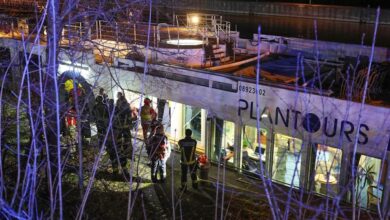Richard Serra dies
The person who came up with the idea for the Holocaust memorial – Richard Serra is dead

He became world famous with some of his huge steel sculptures, which were exhibited in major museums around the world. Now the US artist Richard Serra is dead.
Major artist Richard Serra died on Tuesday in New York State at the age of 85, his lawyer John Silberman confirmed. According to consistent media reports, he died as a result of pneumonia.
With some huge steel sculptures, Serra became one of the most important and successful sculptors in the world. His work has been exhibited from major museums in the USA to the desert of Qatar; he created, among others, the “Terminal” in Bochum, “Torque” in Saarbrücken and “Titled Arc” in New York.
But it was also always controversial. The artist repeatedly emphasized that the popularity of his work meant nothing to him. “I don’t believe that art’s job is to please.”
The idea for the Holocaust memorial in Berlin came from Serra
He withdrew his design for the Holocaust memorial in Berlin during a dispute. The basic idea with a sea of steles came from him. But when his design was changed, Serra no longer wanted to tackle it “for private and artistic reasons.” Another sculpture in New York was dismantled after strong protests. Serra was as “steely and uncompromising as his works,” the British “Guardian” once wrote.
Most of Serra’s works, many of them modeled in Germany, are large and weigh several tons.
The prestigious Guggenheim Museum in New York honored Serra’s work, saying on Tuesday that his “monumental works have changed our perception of space and form.” Many other art critics and journalists expressed their sadness over Serra’s death on social media.
Sculptures made of lead and steel – with curves
Serra most recently lived and worked in New York, Long Island and Nova Scotia, Canada. Serra was born in San Francisco on November 2, 1938, to a Russian mother and a Spanish father. As a child, he could watch the ships in San Francisco Bay from his window – and the fascination with water and large steel structures never left him.
His father worked in a shipyard for several years – where his son’s love of steel structures, which had already been sparked by watching the ships through his childhood bedroom window, was further fueled. “It was a lively environment,” the artist once recalled. “I grew up poor, but the atmosphere was rich.”
Serra studied English literature at the University of California at Santa Barbara and at the elite Yale University. He then went to New York, where he met other artists such as Donald Judd, Dan Flavin and Jasper Johns and soon began experimenting with lead and steel. Serra’s sculptures became larger and heavier and eventually the steel began to curve.
With great effect, as Serra later recounted: “People reacted to the curves in a way they had never reacted to corners and straight lines before. They had never seen that before. People were ready for the curves.” As a result, more and more galleries and renowned museums cleared huge spaces for Serra.
The artist also painted from time to time, but he mostly stayed monochrome. “I’m working on a pink painting,” Serra once told the New York Times. “It’s in my closet. Or green and purple. I was also considering a light yellow-green for a week.” Was he serious? You never really knew that at Serra.

